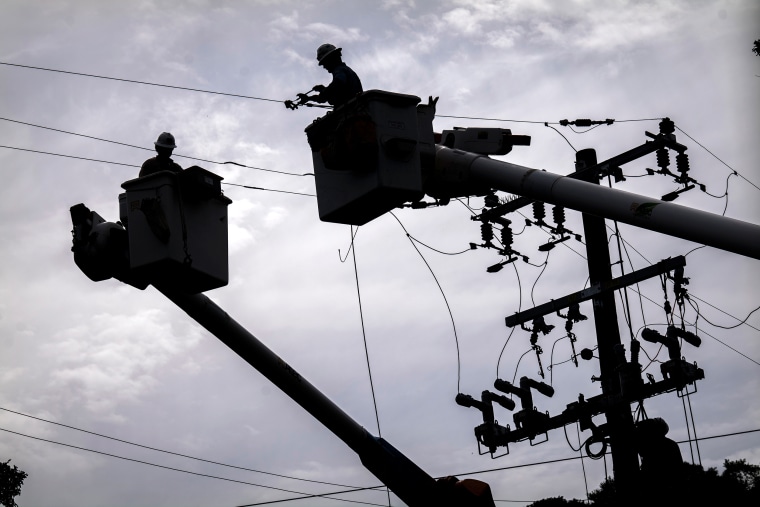As mounting weather-related power failures hammer the country’s electrical grid, a growing number of homeowners are looking for new ways to get their power.
For those with the means, that search has led to a boom in microgrids, which allow residents to hitch a power source such as natural gas, wind or sun to technology that can convert that energy into electricity.
"With a power outage that lasts for days or weeks, you start to think, ‘OK, I need a blackout plan,'" said Isaac Maze-Rothstein, leader of U.S. microgrid research with Wood Mackenzie, an energy research and consultancy group.
After raging wildfires in California, total blackouts in Puerto Rico and icy storms overwhelming Texas, some homeowners in the upper echelons of the housing market are investing thousands of dollars into solar panels and battery storage to serve as their main electrical source — and as backup when power is down for days.
“We’ve probably seen a tenfold increase in residential demand over the past six months,” Zachary Bradford, CEO of Cleanspark, a microgrid outfitter and energy solutions provider, told NBC News.
He attributes part of the increase in demand to statewide power shutoffs in California last year and the country’s aging power grid.
"They’re taking their livelihoods in their own hands."
“I don’t think those issues are going to go away easily, and people who have means, or access to programs that give them the means, they’re taking their livelihoods in their own hands,” he said.
The concept of an independent power system is not new. For decades, independent electricity grids have been fueling power for millions of people in remote communities in Alaska or rural areas of the continental United States, where traditional power lines could not reach them.
More than 2 million homes are already equipped with solar power, and at least 70,000 of those homes have batteries to store excess power that can be used during an outage, according to Maze-Rothstein. That number is expected to almost double by the end of 2021 as home battery storage paired with solar panels becomes more common.
“One of the things we see as an important psychological shift is, if you always thought of the grid as reliable and you have one- or two-hour blackout, you’ll be OK,” he said.
The value of the residential and commercial renewable energy grid markets is expected to soar over the next decade. Eaton, an American power management company headquartered in Ireland, told investors last week that it estimates microgrids will be a $40 billion market by 2030, up from $9 billion this year. Sunrun, which owns about 9 percent of the market share in U.S. residential solar, saw a 350 percent increase in traffic to its site from Texas alone after February's cold snap left millions of state residents without power for days.
“We're excited about what this means for us,” Tom vonReichbauer, chief financial officer at Sunrun solar services provider, said in a company presentation last week. “And I think there's a great opportunity in Texas for solar and storage.”
Although microgrids are an all-encompassing term to capture the diverse ways that people convert energy into electricity, solar and wind power have become cheaper to produce — and state and local tax credits can further lower the cost.
While the federal government and states including Florida and California offer tax rebates and tax credits toward the cost of installing solar power on a home, the cost of one of these systems means it remains a resource only accessible by the wealthy.
A turnkey solar-powered microgrid system with BoxPower, an international solar energy company, can cost up to $45,000 depending on the size of the home, according to company co-founder Angelo Campus. To compare, a propane generator would be about half that cost — without much of a wait for installation. It can take as long as a year for solar panels to arrive because of such high demand.
Renewable microgrids on a neighborhood level have become increasingly attractive to mitigate costs and ensure reliable energy in areas hit by power outages, said Sharelynn Moore, executive vice president of Bloom Energy, which runs about 100 microgrids across the country. For instance, the company partnered with a real estate developer in 2019 to power a 40-acre mixed-use community in Alhambra, California.
Texas is taking notice.
“We’ve been on the phone with county commissioners [in Texas] and large customers,” Moore said. “We have many pricing proposals out with a lot of customers.”
Dale Byrne, a retired retail technology company founder, said he has depended on his solar-powered microgrid to power his Carmel, California, home through 11 outages over the last year. When PG&E, his local utilities company, launched rolling power shutoffs across the state last year, he only noticed the power was down because he could hear his neighbors’ generators humming.
“We never even knew it happened,” he said. “If the power went out again, we wouldn't even know it.”
Byrne worked with Swell Energy, a storage energy provider that helps design at-home microgrids using various company products, to build his solar power system using Sunpower solar panels and a Tesla storage battery. The entire system cost about $50,000, which he paid out of pocket. With state rebates, he lowered his overall cost by somewhere between $20,000 and $25,000, he said. Now, his monthly power bills are about $15.
“I think having this system is a positive thing for us,” he said. “It works well. And I like efficiency.”
